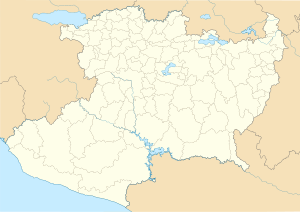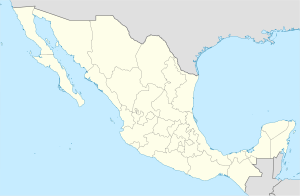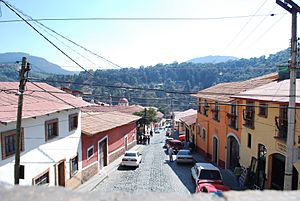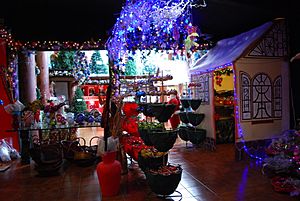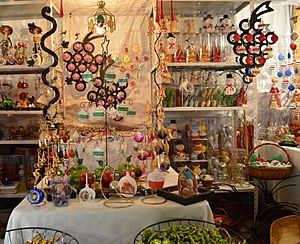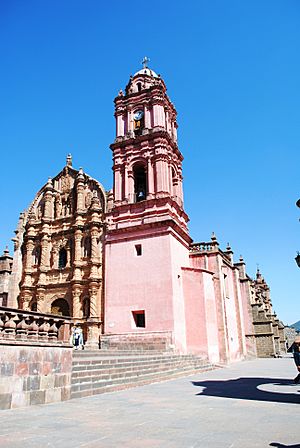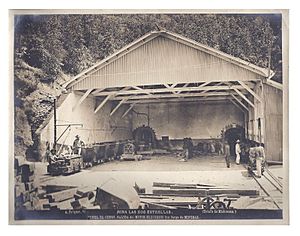Tlalpujahua facts for kids
Quick facts for kids
Tlalpujahua (de Rayón)
|
|
|---|---|
|
Town and Municipality
|
|
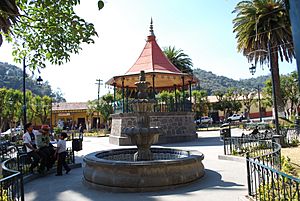
Kiosk in the center of Tlalpujahua
|
|
| Country | |
| State | Michoacán |
| Founded | 1560 |
| Municipal Status | 1822 |
| Area | |
| • Municipality | 190.86 km2 (73.69 sq mi) |
| Elevation
(of seat)
|
2,580 m (8,460 ft) |
| Population
(2005) Municipality
|
|
| • Municipality | 25,373 |
| • Seat | 3,704 |
| Time zone | UTC-6 (Zona Centro) |
| Postal code (of seat) |
61060
|
| Website | www.tlalpujahua.com |
Tlalpujahua (pronounced tlal-poo-HAH-wah) is a town and municipality in the state of Michoacán, Mexico. It's famous for its history as a mining town. In the early 1900s, the Dos Estrellas Mine here was a top gold producer.
A big landslide in 1937 damaged the mine and buried part of the town. Mining stopped completely in 1959. Later, in the 1960s, a local person named Joaquín Muñoz Orta started making Christmas tree ornaments. This grew into a huge industry. Today, Tlalpujahua is a major producer of Christmas items. About 70% of the town's economy comes from this industry.
In 2005, Tlalpujahua was named a Pueblo Mágico. This special title helps attract tourists. The town has narrow stone streets and old houses with red tile roofs.
Contents
Exploring the Town of Tlalpujahua
A Historic Mining Town
The town of Tlalpujahua is quite small, with about 3,700 residents in 2005. Its streets are made of stone and go up and down hills. The houses have thick walls of adobe or pink sandstone. They have pointy roofs covered in red tiles. Some houses even have wooden balconies, looking a bit like chalets. This building style helps keep houses warm in the cold, sometimes snowy winters. The town is surrounded by rugged, forested mountains.
Tlalpujahua's history is closely linked to mining. People mined here even before the Spanish arrived. The busiest mining period was from the late 1800s to the 1930s. The most important mine was the Dos Estrellas Mine. It started in 1898 when a miner found a rich vein of gold. This mine produced 45,000 kg (45 tons) of gold and 400,000 kg (400 tons) of silver.
In 1937, a big landslide damaged the mine. Also, the Mexican government took control of the mine in the 1930s. This meant less money was invested in it. The mine closed in 1959, which was very hard on the town's economy.
Today, the Dos Estrellas Mine is a museum called the Museo Tecnológico Minero Siglo 19. The museum is in the mine's original buildings. It shows old mining equipment and photos from the mining era. It's the first museum of its kind in Mexico. Some buildings are used for workshops. Others, like the old mechanics shop, are left as they were. It's even said that parts for Mexico's first airplane were made here. The museum gardens have sculptures made from mine materials.
The Christmas Ornament Industry
Tlalpujahua is special because it became a major center for making Christmas tree ornaments. This industry started with Joaquín Muñoz Orta. He moved to Chicago in the 1950s and worked in a factory making artificial Christmas trees. In the early 1960s, he returned to Mexico. There was no work in Tlalpujahua, so he went to Mexico City. There, he started a small workshop making Christmas trees.
Soon, they also started making blown glass Christmas ornaments. These became more popular than the trees. By the end of the 1960s, they moved their workshop back to Tlalpujahua. This company is now called Adornos Navideños SA de CV. It has about 1,000 employees and is one of the biggest ornament makers in the world. Each year, the factory makes about 38 million glass spheres. About 26 million of these are sent to other countries.
Besides this large factory, there are about 150 smaller workshops. Many families also make Christmas decorations at home. Even with large production, making the glass spheres is still mostly done by hand. Men usually blow the glass. After cooling, the spheres are covered in a silver solution to make them shiny. They come in many colors like red, pink, yellow, blue, gold, and pearl.
There are over a thousand different ornament shapes. These include fruits, Santa Claus, snowmen, and animals. Workshops have more than 300 designs for the spheres. These designs include hearts, stars, and flowers. Most of the painters are women. The unique designs have made the town famous. The ornament industry employs about 10,000 people. It makes up about 70% of the town's economy.
Every year, from November to early December, Tlalpujahua hosts the Arte Navideño fair. This fair showcases ornaments, trees, and other Christmas decorations. About 60% of the ornaments are exported to countries like the US, Canada, Japan, and Malaysia.
Important Churches in Town
The main church in Tlalpujahua is called the Parish of San Pedro y San Pablo, or sometimes the Del Carmen Sanctuary. It was built in the early 1700s when mining was doing well. It used to have very fancy Baroque decorations inside and out. Today, you can still see the Baroque entrance. In 2009, lights were added to the outside to make it look nice for tourists.
The inside of the church was changed several times. The original decorations were removed. In the late 1800s and early 1900s, an artist named Joaquín Orta Menchaca redecorated it. He used new ways to sculpt flowers and other designs in plaster and ceramic. The walls and ceiling were painted in many colors. This style is unique and a special part of Mexican art.
The church was first dedicated to Saints Peter and Paul. Now, the main altar has a painting of Our Lady of Mount Carmel. This painting is on a piece of an old adobe wall. In 1937, the big landslide buried much of the town. Over 400 people died. Only the bell tower of the old chapel where the painting was located could be seen. The wall with the painting was not damaged. People believe it was a miracle that the landslide stopped just before the wall.
The townspeople carefully cut the adobe wall from the ruined building. They moved it over 1.5 km (about a mile) to the parish church. About 12,000 people helped with this huge effort. In 1965, Our Lady of Mount Carmel became the patron saint of the municipality. On July 16th, thousands of people come to honor her.
The San Francisco monastery was built in the 1600s in Baroque style. The Santiago Puxtla Church was built in the 1500s. It was originally for the local indigenous people. It is still used today, especially for Day of the Dead celebrations. The chapel of Señor Jesús del Monte is one of the oldest churches. It has a statue of Christ made from "pasta de caña" (corn stalk paste), using old indigenous methods.
Other Places to See and Events
The Casa de los López Rayón (Rayon House) is a museum. It tells the story of the town's mining past. It also highlights the Rayon brothers' role in the Mexican War of Independence. The museum opened in 1973. It displays photos, old machines, and letters. Every November 13th, local schools have parades and plays about the Lopez Rayon brothers.
On Sundays, the town has a weekly market. You can find local crafts and food there. Most crafts are Christmas-related. But you can also find feather work, wood items, and pottery. Local dishes include barbacoa and "cabeza de res" (beef head). Both are traditionally cooked in adobe ovens. Other foods include mushroom soups, preserved fruits, and bread made with pulque.
Since 2008, Tlalpujahua hosts the Festival Internacional de Cine Fantástico y de Terror Mórbido. This is an international festival for fantasy and horror films. It happens at the end of October. Besides movies, there are local cultural events, workshops, and music. Films come from Mexico and other countries. They range from old classics to new movies. The festival is held in various places, including the old theater and even inside an old mine. It's a chance for young filmmakers to show their work.
The Tlalpujahua Municipality
The town of Tlalpujahua is the main center for about 80 smaller communities. The entire municipality covers an area of 190.86 square kilometers (73.69 sq mi). In 2005, the municipality had a total population of 25,373 people. Most of these people live outside the main town. The municipality is in the far northeast of Michoacán. It shares a border with the State of Mexico to the east. The capital city of Morelia is 156 km (97 mi) away.
The municipality is part of the Trans-Mexican Volcanic Belt, which means it has many mountains. The Sierra de Tlalpujahua mountain range dominates the area. It has peaks like Somera and San Miguel. The San José River flows through the municipality. There are also fresh water springs and two dams, Brockman and Estanzuela. The climate is mild with rain all year. Temperatures usually range from 6.1°C (43°F) to 22.7°C (72.9°F).
The area has many forests with pine and juniper trees. Wildlife includes cacomixtle, raccoons, and armadillos. The municipality is close to the Monarch Butterfly Biosphere Reserve. It is only 28 km (17 mi) from the Sierra Chincua, a major butterfly sanctuary.
Mining is no longer done in the municipality. The most important economic activity now is making Christmas items. This industry is mainly in the town of Tlalpujahua. It makes up 29% of the local economy. Other products include pencil sharpeners and stone items. Farming and raising livestock are also important. Farmers grow corn, beans, and fava beans. They also raise cattle, pigs, and chickens. This accounts for 20% of the economy.
In recent years, the municipality has worked to attract tourists. The "Pueblo Mágico" status in 2005 helped a lot. There are also tourist attractions outside the main town. The Hermanos Rayón National Park is one such place. It was created in 1952. This area was where the López Rayón brothers had their headquarters during the War of Independence. There is a monument to them at the highest point.
Another eco-tourism spot is the Mineral Casa de Campo. It's in a forest with oak and eucalyptus trees. You can rent cabins there and take tours to nearby monarch butterfly sanctuaries. The Brockman Dam offers activities like camping, mountain biking, and canoeing. It's about 15 minutes from town.
History of Tlalpujahua
In ancient times, the Mazahuas lived in this area. The original name was Tlalpujahuac. This word comes from the Nahuatl language. It means "spongy or flabby land." The Purépecha took control in 1460. But then the Aztecs invaded. The area was often fought over by the Aztec and Purépecha empires. This continued until the Spanish conquered both empires.
After the Spanish conquest, the area became part of an encomienda (a Spanish land grant). Gold had been mined here by indigenous people before the Spanish arrived. In 1558, the Spanish found gold again in these mountains. This brought many Spanish settlers. The mining camp was named Real de Minas de Tlalpujahua in 1560. In 1570, it became a "alcaldia mayor," meaning it was directly controlled by the viceroy.
In 1593, the mining leader, Gaspar de Solís, created the first church for the indigenous people. He also planned the first blocks of a formal Spanish town. The town was officially established in 1603. Churches like Nuestra Señora del Carmen and San Lorenzo were built around this time. The San Francisco monastery and church were also established.
In the early 1700s, a fire destroyed part of the town. Many important buildings and records were lost. A new parish church was built in 1750. By 1765, the church also served nearby communities. The early mines started to run out in 1769.
The town played a role in the early Mexican War of Independence. After Miguel Hidalgo died, Ignacio López Rayón formed a rebel group. When royalist troops arrived in Zitácuaro, he moved his base to his hometown of Tlalpujahua. He and his brothers fortified the Cerro del Gallo Mountain. They made weapons and restarted the fight for independence. Ignacio Rayon also sent a document about a new constitution from here.
In 1813, royalist troops took Tlalpujahua. They forced the rebels to leave Cerro del Gallo. Another independence supporter, Father Juan Antonio Romero, was executed in the town. But Francisco López Rayón took it back in 1815. The war badly damaged the town's economy. Most of its mines were abandoned. Despite this, Tlalpujahua became a municipality in 1822. Mining started again in 1825 with the help of the English, but it only lasted three years.
In 1859, the municipality's name was changed to Mineral de Rayón. This was to honor the López Rayón brothers. Later, it was changed to the current Tlalpujahua de Rayón.
In 1874, the state of Michoacán tried to restart large-scale mining. Success came at the end of the century. A large vein of gold was found in 1898. This made Tlalpujahua the most important gold producer between 1908 and 1913. This discovery led to the Dos Estrellas Mine. New technology from France and England helped old mines become profitable again. This brought foreign workers from Europe, the U.S., and Asia to Tlalpujahua and nearby El Oro. Modern things like railroads and telegraphs also arrived. Tlalpujahua even claims to have had electric lights before Mexico City.
Mining stopped suddenly on May 27, 1937. A huge landslide buried about one-third of the town. It also damaged the Dos Estrellas Mine. The material was mining waste, which turned into a kind of concrete when it settled. Today, only the tower of the old chapel can be seen from the buried area. The landslide damaged the mine. But it was the government taking control of the mine in the 1930s that led to its closing in 1959.
Since Dos Estrellas was the main source of jobs, its closing almost ended mining in Tlalpujahua. People started moving away. The population dropped from 25,000 in the 1930s to only 600 in 1960.
All mining stopped in 1959. The rise of the Christmas tree ornament industry and tourism has helped the economy recover. The ornament industry began with Joaquín Muñoz Orta. He worked in Chicago making artificial Christmas trees. He returned to Mexico in the early 1960s. He started a small Christmas tree workshop in Mexico City. Soon, they also made blown glass ornaments, which became very popular. Eventually, they moved their workshop back to Tlalpujahua. This company is now Adornos Navideños SA de CV. Today, it has about 1,000 employees and many workshops.
Images for kids
See also
 In Spanish: Tlalpujahua de Rayón para niños
In Spanish: Tlalpujahua de Rayón para niños


